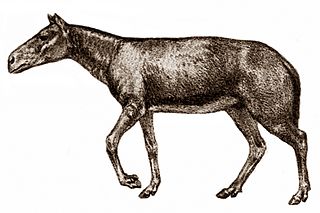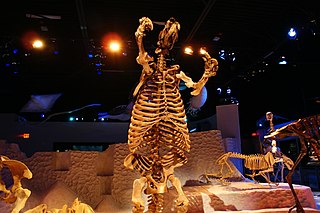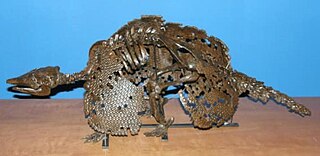
The Florida Museum of Natural History (FLMNH) is Florida's official state-sponsored and chartered natural-history museum. Its main facilities are located at 3215 Hull Road on the campus of the University of Florida in Gainesville.

Hemicyon, also known as the "dog-bear", is an extinct genus of hemicyonine bear, which probably originated in Eurasia but was found in Europe, Asia and North America during the Miocene epoch, existing for approximately 16 to 13 mya. Hemicyon is the best-known genus in the Hemicyoninae, a subfamily intermediate between bears and their Caniform ancestors but most often classified as bears. Hemicyonid bears should not be confused with Amphicyonids (bear-dogs), which are their own separate family of carnivores.

Daphoenus is an extinct genus of amphicyonids. Daphoenus inhabited North America from the Middle Eocene to the Middle Miocene, 37.2—16.0 Mya, existing for approximately 21 million years.
Parictis is an extinct arctoid belonging to the family Subparictidae.
Parahippus leonensis is an extinct proto-horse of the family Equidae that was endemic to North America during the Miocene from 23.030 to 16.3 Ma living for approximately 6.73 million years.

Tylocephalonyx is an extinct chalicothere from the Miocene of North America.

Archaeohippus is an extinct three toed member of the family Equidae known from fossils of early Oligocene to middle Miocene age. The genus is noted for several distinct skeletal features. The skull possesses deeply pocketed fossa in a notably long preorbital region. The genus is considered an example of phyletic dwarfism with adults estimated at being on average 20kg in weight. This is in contrast to the most common equid of the period, Miohippus. Characters of the teeth show a mix of both primitive and advanced traits. The advanced traits are very similar to those shown in the genus Parahippus. The noted similarities of Archaeohippus and Parahippus show them to be descended from a common ancestor and are considered sister species.

Thinobadistes is an extinct genus of ground sloth of the family Mylodontidae endemic to North America during the Miocene-Pliocene epochs (Hemphillian). It lived from 10.3 to 4.9 mya, existing for approximately 5.4 million years.

Osbornodon iamonensis is an extinct species of hesperocyonine, a predecessor of modern dogs that were endemic to North America and which lived from the Oligocene to Early Miocene epoch 23.6—16.3 Ma and existed for approximately 8 million years. It was named for Lake Iamonia in northern Florida. Fossils have been found in Florida and Nebraska. In the Thomas Farm Site in Gilchrist County, Florida, it is the most common carnivore found in that area.

The Thomas Farm site is an Early Miocene, Hemingfordian assemblage of vertebrate fossils located in Gilchrist County, northern Florida.
Floridaceras is an extinct genus of rhinocerotid of the Miocene epoch, endemic to North America, living from around ~20.6–16.3 Ma, existing for approximately 4.3 million years.

Pachyarmatherium is a genus of extinct large armadillo-like cingulates found in North and South America from the Pliocene and Pleistocene epochs, related to the extant armadillos and the extinct pampatheres and glyptodonts. It was present from 4.9 Mya to 11,000 years ago, existing for approximately 4.889 million years.

Stanley John Olsen was an American vertebrate paleontologist and one of the founding figures of zooarchaeology in the United States. Olsen was also recognized as an historical archaeologist and scholar of United States military insignia, especially buttons of the American Colonial through Civil War periods. He was the father of John W. Olsen.
Ekgmowechashala is an extinct genus of primate belonging to Adapiformes.

Paleontology in Florida refers to paleontological research occurring within or conducted by people from the U.S. state of Florida. Florida has a very rich fossil record spanning from the Eocene to recent times. Florida fossils are often very well preserved.
The Parachucla Formation is a geologic formation in Florida. It preserves fossils dating back to the Paleogene period.
The Alachua Formation is a Miocene geologic formation in Florida. The claystones, sandstones and phosphorites of the formation preserve many fossils of mammals, birds, reptiles and fish, among others megalodon.

Alligator olseni is an extinct species of alligator. They lived in the Early Miocene period, around 20.4–15.97 million years ago and possibly earlier. Their range was principally in what is now known as Florida, United States, and possibly extending into southeastern Texas.
Pomatodelphis is an extinct genus of river dolphin from Middle Miocene marine deposits in Alabama, Florida, Brazil, Germany and France.
Bairdemys is an extinct genus of side-necked turtles in the family Podocnemididae. The genus existed from the Late Oligocene to Late Miocene and its fossils have been found in South Carolina, Puerto Rico, Panama and Venezuela. The genus was described in 2002 by Gaffney & Wood and the type species is B. hartsteini.













